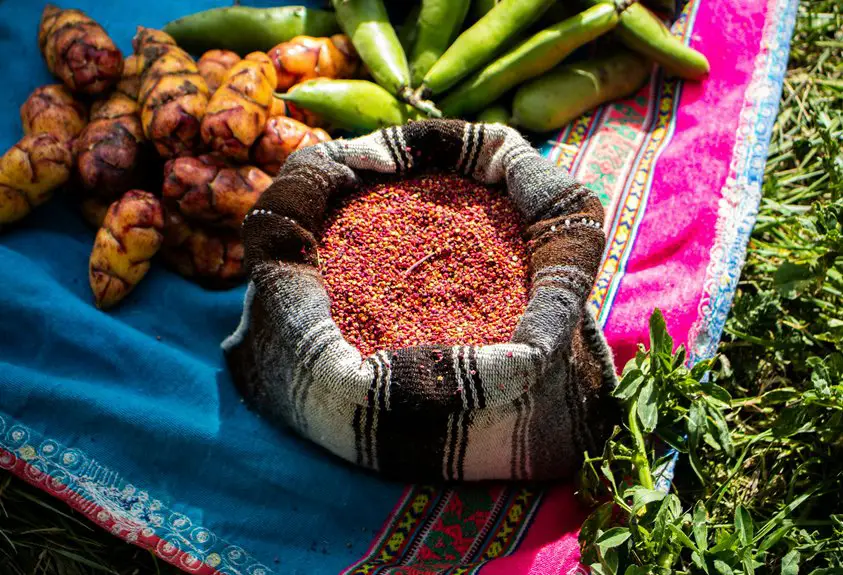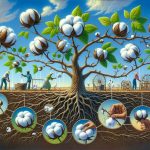Monoculture farming for textiles might seem efficient, but it carries significant consequences for biodiversity. By prioritizing single-crop plantations, we’re not just altering landscapes; we’re disrupting entire ecosystems. This shift raises critical concerns about habitat loss and the health of our natural environments. What does this mean for the future of our ecosystems and the delicate balance they maintain? Understanding these impacts is essential for addressing the sustainability challenges we face today.
Table of Contents
Key Takeaways
- Monoculture farming for textiles replaces diverse ecosystems with single-crop plantations, leading to significant biodiversity loss.
- The reliance on chemical inputs in monoculture farming harms soil health and disrupts surrounding ecosystems, affecting plant and animal life.
- Loss of diverse habitats impacts pollinator populations, threatening the reproductive success of plants essential for textile fibers.
- Declining biodiversity from monoculture practices affects the entire food web, disrupting ecological balance and threatening larger wildlife.
- Sustainable practices, such as crop rotation and organic farming, can mitigate biodiversity loss and promote healthier ecosystems in the textile industry.
Habitat Disruption and Biodiversity Loss
As monoculture farming expands, it disrupts natural habitats and leads to significant biodiversity loss. You mightn’t realize how these vast fields of a single crop replace diverse ecosystems, pushing out native species.
When you drive through rural areas, notice the lack of variety in plant life; this affects not just plants but also insects, birds, and other wildlife. Without diverse habitats, pollinators struggle to survive, and predators lose their food sources.
If you’re concerned about the environment, recognize that monoculture reduces resilience against pests and diseases. You’re witnessing ecosystems collapsing as their complexity diminishes.
Embracing agricultural diversity can restore balance, ensuring that nature thrives alongside farming. You have the power to support efforts that protect biodiversity in your community.
Chemical Use and Its Ecological Consequences
While monoculture farming promises higher yields, it often relies heavily on chemical inputs that can have dire ecological consequences.
You mightn’t realize that pesticides and fertilizers, essential for maintaining these high yields, can leach into surrounding ecosystems. This chemical runoff contaminates soil and water, affecting not only plant life but also the animals that depend on these habitats.
Over time, you’ll notice a decline in soil health, as essential microorganisms are killed off, leading to nutrient depletion. Additionally, the reliance on herbicides can create resistant weed species, forcing farmers to use even more chemicals.
The decline in soil health due to chemical reliance threatens ecosystems and forces increased chemical use.
Your choices in supporting sustainable practices can help mitigate these impacts, promoting a healthier ecosystem and protecting biodiversity for future generations.
The Decline of Pollinators and Ecosystem Health
The heavy reliance on chemicals in monoculture farming not only harms soil health but also contributes to the alarming decline of pollinators.
You mightn’t realize it, but these tiny creatures play an essential role in our ecosystems. As pollinators vanish, the plants that rely on them for reproduction also suffer, leading to reduced biodiversity.
This loss impacts not just agricultural yields but the entire food web, affecting everything from small insects to larger animals. When you consider how interconnected these systems are, it becomes clear that a decline in pollinators threatens overall ecosystem health.
Sustainability Challenges in the Textile Industry
Steering through sustainability challenges in the textile industry can feel overwhelming, especially when you consider the environmental and social impacts of fast fashion.
You might notice how the production process demands massive water consumption and generates significant waste. The reliance on synthetic fibers contributes to microplastic pollution, affecting marine life and ecosystems.
Additionally, labor practices in many textile factories raise ethical concerns about workers’ rights and safety. It’s essential to recognize that these issues don’t just affect the environment; they impact communities and economies globally.
As you navigate your choices, remember that the textile industry’s sustainability challenges are interconnected, and understanding them is the first step toward making more informed decisions that support ethical and environmentally friendly practices.
Potential Solutions for a Biodiverse Future
As you explore sustainable practices in various industries, it’s clear that biodiversity plays a pivotal role in ensuring a healthier planet.
To promote a biodiverse future in textile farming, consider these solutions:
- Crop Rotation: Implementing crop rotation can enhance soil health and reduce pest populations, supporting a diverse ecosystem.
- Agroforestry: Integrating trees into farming systems can create habitats for wildlife, improve soil quality, and increase resilience against climate change.
- Organic Farming: Adopting organic methods minimizes the use of harmful chemicals, fostering a thriving environment for various species.
Frequently Asked Questions
How Does Monoculture Farming Affect Local Economies?
You might think monoculture farming boosts local economies, but it often leads to dependency on a single crop. This reliance can stifle diversity, making communities vulnerable to market fluctuations and environmental changes that threaten their livelihoods.
What Role Do Consumers Play in Promoting Biodiversity?
You play an essential role in promoting biodiversity by choosing sustainable products, supporting local farmers, and advocating for eco-friendly practices. Your purchasing decisions influence markets, encouraging brands to prioritize biodiversity over harmful farming methods.
Are There Alternatives to Cotton in Textile Production?
You can weave creativity into your wardrobe by exploring alternatives like hemp, linen, and bamboo. These fibers dance with sustainability, offering vibrant options that breathe life into fashion while nurturing our planet’s delicate ecosystems.
How Can Farmers Transition From Monoculture to Diverse Practices?
You can shift from monoculture to diverse practices by gradually introducing cover crops, rotating crops, and incorporating agroforestry. These methods enhance soil health, promote biodiversity, and ultimately lead to a more sustainable farming system.
What Is the Impact of Monoculture on Indigenous Species?
You’ll notice fewer butterflies and birds in fields dominated by monoculture. This uniformity disrupts local ecosystems, pushing indigenous species toward extinction. When variety thrives, so do the creatures you cherish, enriching both land and life.
- Understanding the Aramid Fabric Market in China - June 22, 2025
- A Guide to Wholesale Aramid Fabric Suppliers - June 22, 2025
- Aramid vs. Covec: Which Is Better for Motorcycle Gear? - June 22, 2025



